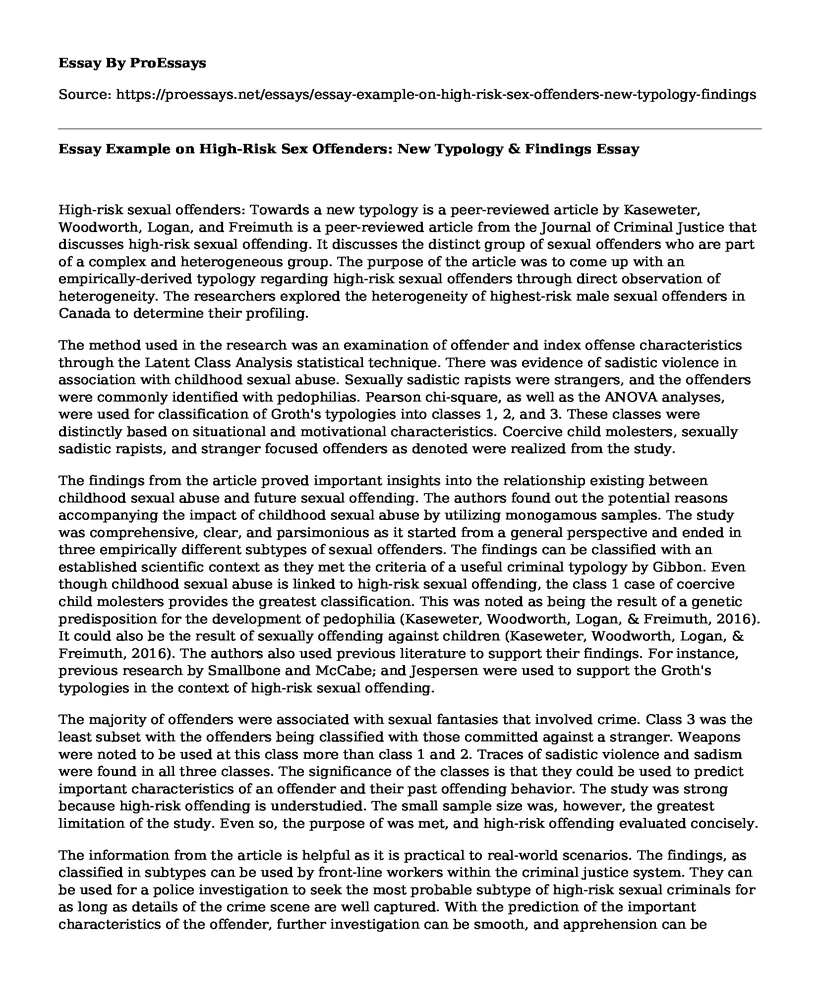High-risk sexual offenders: Towards a new typology is a peer-reviewed article by Kaseweter, Woodworth, Logan, and Freimuth is a peer-reviewed article from the Journal of Criminal Justice that discusses high-risk sexual offending. It discusses the distinct group of sexual offenders who are part of a complex and heterogeneous group. The purpose of the article was to come up with an empirically-derived typology regarding high-risk sexual offenders through direct observation of heterogeneity. The researchers explored the heterogeneity of highest-risk male sexual offenders in Canada to determine their profiling.
The method used in the research was an examination of offender and index offense characteristics through the Latent Class Analysis statistical technique. There was evidence of sadistic violence in association with childhood sexual abuse. Sexually sadistic rapists were strangers, and the offenders were commonly identified with pedophilias. Pearson chi-square, as well as the ANOVA analyses, were used for classification of Groth's typologies into classes 1, 2, and 3. These classes were distinctly based on situational and motivational characteristics. Coercive child molesters, sexually sadistic rapists, and stranger focused offenders as denoted were realized from the study.
The findings from the article proved important insights into the relationship existing between childhood sexual abuse and future sexual offending. The authors found out the potential reasons accompanying the impact of childhood sexual abuse by utilizing monogamous samples. The study was comprehensive, clear, and parsimonious as it started from a general perspective and ended in three empirically different subtypes of sexual offenders. The findings can be classified with an established scientific context as they met the criteria of a useful criminal typology by Gibbon. Even though childhood sexual abuse is linked to high-risk sexual offending, the class 1 case of coercive child molesters provides the greatest classification. This was noted as being the result of a genetic predisposition for the development of pedophilia (Kaseweter, Woodworth, Logan, & Freimuth, 2016). It could also be the result of sexually offending against children (Kaseweter, Woodworth, Logan, & Freimuth, 2016). The authors also used previous literature to support their findings. For instance, previous research by Smallbone and McCabe; and Jespersen were used to support the Groth's typologies in the context of high-risk sexual offending.
The majority of offenders were associated with sexual fantasies that involved crime. Class 3 was the least subset with the offenders being classified with those committed against a stranger. Weapons were noted to be used at this class more than class 1 and 2. Traces of sadistic violence and sadism were found in all three classes. The significance of the classes is that they could be used to predict important characteristics of an offender and their past offending behavior. The study was strong because high-risk offending is understudied. The small sample size was, however, the greatest limitation of the study. Even so, the purpose of was met, and high-risk offending evaluated concisely.
The information from the article is helpful as it is practical to real-world scenarios. The findings, as classified in subtypes can be used by front-line workers within the criminal justice system. They can be used for a police investigation to seek the most probable subtype of high-risk sexual criminals for as long as details of the crime scene are well captured. With the prediction of the important characteristics of the offender, further investigation can be smooth, and apprehension can be facilitated easily. The contents from the article can also be used to substitute knowledge of the victim relations that is of limited importance during profiling. With more information, the suspect pool can be narrowed, consequentially increasing successful apprehension of the sexual offenders.
References
Kaseweter, K., Woodworth, M., Logan, M., & Freimuth, T. (2016). High-risk sexual offenders: Towards a new typology. Journal of Criminal Justice, 47, 123-132.
Cite this page
Essay Example on High-Risk Sex Offenders: New Typology & Findings. (2023, Feb 23). Retrieved from https://proessays.net/essays/essay-example-on-high-risk-sex-offenders-new-typology-findings
If you are the original author of this essay and no longer wish to have it published on the ProEssays website, please click below to request its removal:
- Fake News Discussion
- William Rodriguez Case Study
- Paper Example on UK Housing Law: Assured Shorthold Tenancy & Effects
- Essay Example on Protecting the US Homeland: The 2002 Emergency Preparedness Act
- Essay Example on Prisoner Rights in US Supreme Court: Brown v Plata Case
- Paper Sample on Parent-Only Treatment Effective for Childhood Obesity: A Randomized Controlled Trial
- Essay Example on Life Expectancy







